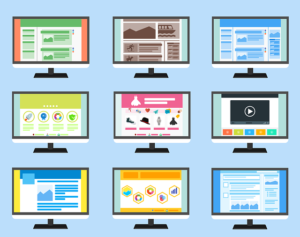Single-Page Vs. Traditional Site: How Many Pages Does Your Website Need?
Every website is different. There is no magical cookie-cutter solution to building websites that works for all people and organizations, but no matter which structure you choose, navigation is a priority. While ecommerce sites will naturally have more pages on average than non-commerce sites, even if you don’t have a product or service to sell online you need to connect with your readers.
So how many pages does it take to do the job well?
Technically, you need to have only one page to have a website. Single page sites, where users navigate a single page by scrolling vertically and/or horizontally, are making a lot of headway in the world of traditional sites, and they have their fair share of pros and cons.
My own site is currently a single page. Like many of my readers, I built it myself by modifying an existing template, and while multiple pages are an option I might use, I find that single page worked best for me. Why?
 Single page sites promote simplicity and demand concise content, which is exactly what I focus on as a writer. Even though my previous site was based on a parallax design, it included nearly two dozen pages of additional content that most visitors never even read.
Single page sites promote simplicity and demand concise content, which is exactly what I focus on as a writer. Even though my previous site was based on a parallax design, it included nearly two dozen pages of additional content that most visitors never even read.
By condensing all of that bulky content and skimming the cream, I now get my information across quickly and efficiently. It works. Conversions don’t lie, and my conversion rate tripled after I made the switch.
Single page sites won’t work for everyone, though. Spreading your content over several pages can make it easier for readers to focus on specifics and consume the information you present. The key is to figure out what site design and content will work best for you.
Here is a general overview of both single-page and traditional sites that can help you decide which is the best venue for your message.
Table of Contents
Single Page & Parallax Websites
- You prefer simple and modern.
- You are presenting a single product, service or suite of services.
- Your content is not overly technical.
- Your content is based on simple images and/or text.
- Your product or service is highly tailored to each client.
Single page sites can be both simple and powerful. In fact, they can make more of an impact than traditional multi-page sites and are often more engaging as a result of their limitations. While they are simple, single page sites are usually anything but plain, and are usually incorporate interactive and cutting-edge design elements.
I am both a freelance writer and minimalist at heart. My work varies by client, and each potential client has a different set of needs and initial questions. I could certainly try to answer them all with a long FAQ list, but I’d rather have the opportunity communicate directly with each client.
So a simple, single-page website with basic information on my services, written in my preferred conversational tone, entices the reader to contact me for more information. Boom! Conversion. Okay, okay, not everyone who contacts me becomes a paying client, but in my line of work making contact is half the battle.
Cons? Well, it depends.
- Readers don’t mind scrolling a little, especially as scrolling sites become more commonplace, but don’t make them scroll for miles.
- Too much visual content on a single page website can kill loading times. This was another problem I faced with my single-page parallax site. It took forever to load, and internet users have notoriously short attention spans. They’ll just ditch your site for the next one down on the search results page if your site is too slow to load.
- Finally, search engine optimization (SEO) can reportedly prove a bit trickier with single page sites, although opinions vary from “it will ruin you!” to “eh, no problem.”
Keep your content clean, lightweight and easy on the eyes while scrolling or ditch a single page or parallax site for a traditional design, although the same rules apply there.
Traditional Multi-Page Sites
- Your audience is traditional.
- You run an ecommerce site.
- You are presenting technical information.
- You have a lot of visual media.
- You have a lot of anything, unless it’s just copy, in which case, why?
If you decide that a traditional site structure is best for you, make sure your content is concise and formatted for skimming. You’ll want to include at least the following three pages:
 Home Page | 150-450 words
Home Page | 150-450 words
This is the main page to which your domain is connected, and can easily double as the About page although if your company has an in-depth history or unusual back story then consider a separate About page.
Think of your home page as a billboard in a prime location. It should convey what your website and brand are about, and since you only have a few seconds to capture the viewer’s attention before they move on to the next website, the purpose and tone of your site must be easily discernible at a glance from this page.
Contact Page | 50-150 words
This is a simple page with all of the contact information on it that viewers may use to reach you. At the very least, list a phone number and email address, and consider recapping pertinent information about your services.
Services or Products Page | 250-450 words
This is where you can describe your services or products in detail, along with guarantees and return policies.
This is often the core of a website and why viewers stay on it to read or come back later. There are two types of content pages to consider: static and fresh.
Static content is usually evergreen, meaning always relevant, and stays put on a site’s menu, much like your contact page. Fresh content, such as through a blog, can include seasonal or other topical content and can be categorized and pulled up through searches. Newer content precedes older posts.
Either way, useful content that related to your industry or niche, especially when published regularly, will keep readers coming back.
 Cons of a multi-page site?
Cons of a multi-page site?
- Well, internet users are lazy, and by adding multiple pages you are asking them to take a lot of action. If you have more than a few pages, make sure your menu is set up for painless navigation.
- While one of the pros of multi-page design is that you can add more content without compromising page load times (since all of that content is spread out over multiple pages rather than just one), the flip side is that you will probably add more content just because you can. Unfortunately, more doesn’t usually mean better. In fact, more will often be ignored by the reader. Don’t make that mistake. Keep your pages clean, no matter how many you have.
- Finally, your calls to action and (vital!) contact information can get lost in the pages. Make sure that doesn’t happen.
Put a contact form on every page if you have to. I do.
So, How Many Pages – Is there a “Best” website structure?
A Home (and combined or optional About) page, Contact page, Product or Services page, and optional Content pages are usually required to publish a professional, engaging site.
Then again, rules are often broken to good effect, so break them if it suits you. For example, having modern parallax site in an industry dominated by traditional websites could easily help your brand stand out and appeal to a younger audience.
I added a blog to my menu, and I’ll probably include a portfolio page soon. Will it still be considered a single page site? Not technically, but the main page of my site could effectively stand alone, and that is what’s important to me.
Want more information?
- Read about image compression for faster page loading times.
- Here are 18 image compression tools.
- Single page websites and SEO.
- A little more about single page and parallax sites and SEO.
- Benefits of a single-page site.
The goal of any site is to get attention, engage readers and turn them into customers. No matter which design you choose, keep your content concise and your calls to action clear.
Also, hire a professional copywriter for your website. Ahem. The fee is usually more reasonable than you might think, and increased engagement and conversions (such as turning readers into customers) make for a pretty sweet return on investment.
About the Author: Karri Stover

As a small business owner or entrepreneur, you need custom content to grow you business. A professional writer will create the kind of content that builds trust, brand loyalty and your customer base.
High quality custom content is probably more affordable than you think, and worth every dime. Get in touch, and let’s start building a beneficial working relationship.



